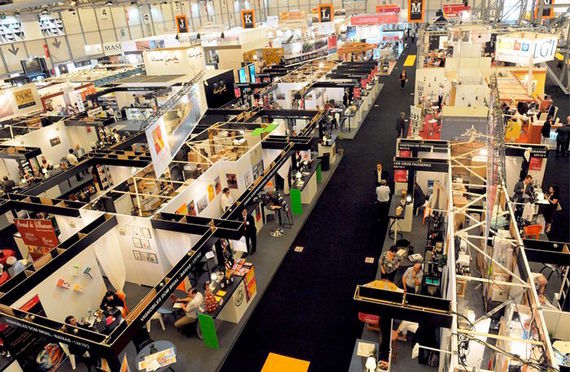These are neither the best of times nor worst of times for the global wine and spirits markets, but it is a time of uncertainty about the economy, politics and societal changes that make predictions about the future more difficult than it's been in a long time.
For while the 1980s and 1990s were a period of soaring expectations--and not a little hype--it did seem the whole world was becoming more interested and could better afford to buy more wine and spirits than at any time in history. Then came 9/11, the debacle of 2008, the economic collapse of Greece, Ireland and Spain, and increasing terrorism in major cities, topics to be discussed at the VINEXPO trade show in Bordeaux this summer (below).
To an extent, wine and spirits sales overall are still rising, but the future is anything but certain. Vodka still dominates spirits sales, and whiskies and bourbons are projected to rise 8.8% and 19.3% respectively over the next five years. These and a great deal more data have just been released by the IWSR, a forty-year old marketing company that tracks brand performance in 125 countries across the world using local market input from distributors, importers, producers, retailers, duty-free and gray operators in each country.
To find out the effects of all these data, I had a conversation by phone with Guillaume Deglise (below), CEO of Vinexpo, which commissioned the IWSR report, to ask which and how forces will drive the market in 2015 and beyond.
Q. Your new report makes much of the impact of the Asian market on global sales, but there is also some caution in it.
A. While 2013 growth in the region has been curtailed by the Chinese government's anti-corruption legislation, five-year forecasts remain positive at about 3.5% growth. Cognac and Armagnac have found new markets in Asia, and sales rocketed by 19% from 2009-12 and are expected to grow annually at a 3% rate. But there too the Chinese have been forced to cut back. Right now Asia-Pacific accounts for 63% of the world's total spirits consumption.
Q. Which categories are showing the most growth in spirits?
A. Premium whiskies and Kentucky bourbons are back in vogue, with Russia, Brazil, Mexico, India and Poland driving forces outside of the U.S. Vodka is still number one in sales but that's leveling out now. Baijiu, a spirit like vodka made and mostly consumed in China, is the number one best seller of all.
Q. Are the current sanctions against Russia and falling oil prices going to hurt the Russian market?
A. Russia is difficult to predict. Vodka is still the best-selling spirit there, but the younger generation does not want to pursue the same habits of their elders. They are much more open to spirits from outside Russia.
Q. What about the weakening of the euro? How will that affect global sales of European wines and spirits?
A. The industry has, as a result of the stronger dollar, become much more competitive than in the past. A strong dollar translates to lower prices for French, Italian and Spanish wines and spirits, which offers clear advantages on the international scene. I don't think export will be much affected through 2016 but that depends on the future value of the euro.
Q. Do you think some producers in Europe will try to make up for the falling price of the euro by hiking their own prices?
A. It will depend on the price category of each wine and on the stocks available. If there is a lot of stock, they won't push prices up; they'll look to improve their margins. Remember, the U.S. is still the largest consumer of wines and spirits in the world. Some producers of very high-end, rare wines and spirits may raise their prices.
Q. What about sparkling wines?
A. Sparkling wines (excluding Champagne) accounted for 8% of the world's wine consumption - and are expected to rise to 8.9% by 2018. Spanish cava sales, spurred by growth in imports to Belgium, Nigeria and France, escalated by more than 100,000 cases in 2013. In that same year Italian prosecco sales doubled.
Q. Has this hurt Champagne sales?
A. I used to work for Champagne, so I know it well, and consumption has dipped--1.4% globally in 2013-- as consumers everywhere look to cheaper alternatives like prosecco and cava. Outside of France, Champagne is perceived as very high priced, only for special occasions, but I believe it still has a quality that cannot be matched, and grape prices in Champagne are very high. Even though French consumption is down, they continue to drink Champagne because they have access to many more inexpensive labels. Champagne sales are increasing, however, in the U.K, U.S, Australia and Japan.
Q. What about wine consumption?
A. Red wine continues to dominate, representing 54.8% of all still wine consumed in 2013. Reduced demand, primarily in China--where more than 90% of wine consumed is red--drove worldwide consumption down by 19.8 million cases. Rosé sales are going up nicely, by about 9%.
Q. Recent reports indicate that the business lunch has not only declined in importance because have so little time and are forced to eat at their desk, but that when they do dine out they order less and cheaper wines. Do you see that in France, too?
A. Oh, yes, there is a big change in consumption patterns everywhere. Business people don't take as much time to enjoy lunch, and they drink less, though they drink better wines. Not the high-end labels, however, because the executives cannot be seen showing off to their clients the way they once did. Expense accounts have been cut and, as you know, we are still in a deep economic crisis in Europe.
Q. Is there a bright spot somewhere in that?
A. Yes, the younger generation, especially in France, is spending more time in wine bars and bistros. The sales are now being driven by them.

